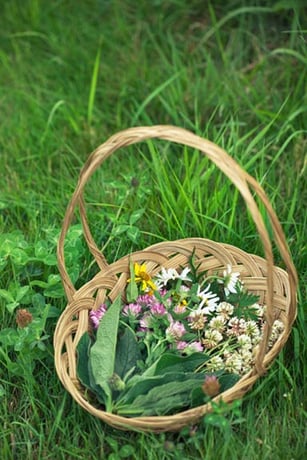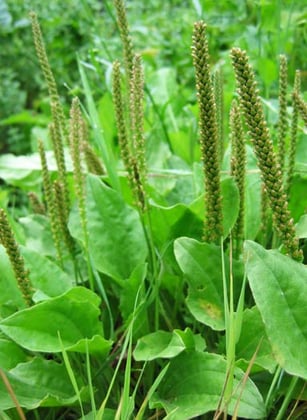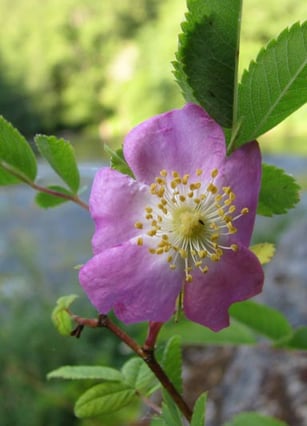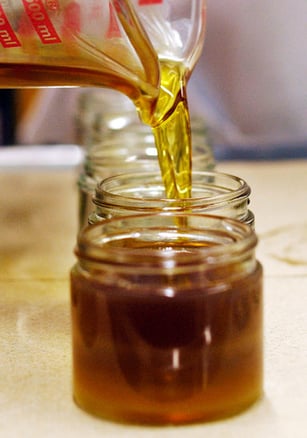What fun it is to explore fields and woods, bringing home wild plants to transform into healing products!
What fun it is to explore fields and woods, bringing home wild plants to transform into healing products! Many wild weeds are a treasure trove of vitamins, minerals, and properties which help soothe and heal the skin. When harvesting wild flora, make sure and do so in a harmonious and respectful way that will not negatively impact your local eco-system. To learn more about identifying and harvesting wild plants, look for local field guides such as Peterson Field Guide to Eastern Medicinal Plants or Medicinal Plants of the Pacific West.
Balm of Gilead Buds (Populus balsamifera) - Buds from Cottonwood Poplar trees are ideal for ointments, salves, and oils to treat minor wounds and skin injuries.
Blackberry(Rubus fruticosus) – Not only are Blackberry leaves abundant, they are also a gentle astringent for normal and oily skin. Use in facial steams or brew with boiling water, strain, cool and use as a facial toner.
Chickweed (Stellaria media) - A source of minerals and excellent for poultices, skin irritations, and eye inflammations. This herb is often used in salves because it is so soothing to the skin.
Comfrey (Symphytum officinale) – Comfrey root and leaf can be brewed into an infusion and applied as a gentle and soothing toner beneficial for sensitive or dry skin. This mucilaginous herb can also be incorporated into salves, poultices, and ointments. The root or leaf can be used similarly, but the root is stronger.
Elder (Sambucus nigra) – A traditional cosmetic wash created by brewing a tea from the fresh flowers. May be applied as a facial toner or as a wash for soothing eye and skin irritations.
Horsetail (Equisetum arvense) – Naturally high in silica, this herb strengthens and conditions hair. Make a water infusion and apply after washing your hair, or infuse in Olive Oil to use in hot oil treatments.
Nettles (Urtica dioica) – This wondrous herb is a cherished source of minerals, strengthening, and astringent. Use in hair treatments to stimulate circulation at the scalp and encourage hair growth and in facial care to tone oily, normal, combination, or acneic skin. Nettle is also beneficial as a healing wash to cleanse wounds and sores.
Plantain (Plantago major or Plantago lanceolata) – The folkloric name for this herb is “Green Bandage” for obvious reasons. Plantain is one of the best poultice herbs available. The fresh leaves applied as a poultice soothe irritations and infections, while the dried and powdered leaf can be used as an herbal first-aid powder for infections.
Red Clover (Trifolium pretense) – Not only are they beautiful, but the blossoms are calming and cleansing. Especially beneficial when used in facial treatments for dry or irritated skin. Toss a handful into a bowl of boiling water for a gorgeous facial steam!
Self Heal (Prunella vulgaris) – This common weed has medicinal properties, and is a traditional remedy to treat cuts, abrasions, and bruises.
St. John’s Wort (Hypericum perforatum) – Traditionally infused fresh in Olive Oil, this weedy herb grows readily along roadsides and in disturbed areas and is a fabulous remedy to support nerves, minor burns, wounds, bruises, and sprains.
Wild Rose (various wild species) – Leaves from Wild Rose plants are astringent and toning. They can be added to facial steams or infusions as a gentle astringent for normal, oily, or combination skin. The fresh leaves can be applied as a poultice for bee stings and insect bites.
Yarrow (Achillea millefolium) – A very strong natural astringent. A poultice of crushed fresh Yarrow leaves can stop bleeding, and an infusion made from the flowers can be used for skin. The dried powdered leaf can be used in a first-aid kit and applied to cuts and wounds to disinfect and stop bleeding.
Horsetail & Nettle Hair Rinse
Place 1-2 handfuls of fresh Horsetail and/or Nettles in a glass mason jar, fill with boiling water, and cap tightly. Allow to infuse for 2 or more hours, and then strain out the herbs (great for compost!). After washing hair, rinse with the liquid.
Wild Plant Facial Steam
1-2 handfuls of fresh wild plants (choose one or a mixture: Red Clover Flowers, Elder Flowers, Wild Strawberry leaves, Blackberry leaves, or Rose Hip leaves).
Place fresh herbs into a large ceramic or glass bowl. Boil water and pour over herbs, immediately placing a towel or lid over the bowl so that the oils being released from the herbs do not escape. Steep for 5 minutes. Place the bowl on a table or other surface where you can comfortably sit and hold your face over the bowl covering your head and the bowl with a large towel to make sure that no steam can escape. Make sure to keep your eyes closed and breathe deeply to inhale the therapeutic properties of the herbs. Steam for 10 minutes.
Healing Weed Oil & Salve
Choose one or a mixture: Balm of Gilead buds, Chickweed, Comfrey, Nettles, Plantain, Self Heal, St. John’s Wort, or Yarrow.
Wilt fresh herbs for 12 hours to remove most of the moisture (too much moisture will cause your oil to go rancid), cut into small pieces, and crush with a mortar and pestle before adding to a clean mason jar. Cover the herbs thoroughly with organic Olive oil, cap tightly, and place in a sunny windowsill. Shake the jar daily for 6-8 weeks, then strain the herbs out and bottle the remaining oil. This healing oil can be used on small cuts, scrapes, insect bites, and other minor skin wounds.
To make a salve, combine 4 oz of herbal oil with 1/2 oz of beeswax and melt gently over a double boiler until the beeswax melts. If desired, add 20 drops of Lavender essential oil for its therapeutic properties. Remove from heat and quickly pour into tins or glass jars and allow to cool before capping with lids.
~ irene














